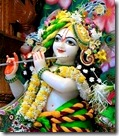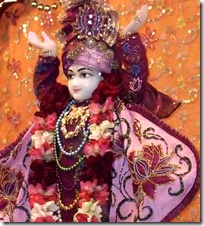 “Always chanting My glories, endeavoring with great determination, bowing down before Me, these great souls perpetually worship Me with devotion.” (Lord Krishna, Bhagavad-gita, 9.14)
“Always chanting My glories, endeavoring with great determination, bowing down before Me, these great souls perpetually worship Me with devotion.” (Lord Krishna, Bhagavad-gita, 9.14)
Download this episode (right click and save)
सततं कीर्तयन्तो मां
यतन्तश् च दृढ-व्रताः
नमस्यन्तश् च मां भक्त्या
नित्य-युक्ता उपासते
satataṁ kīrtayanto māṁ
yatantaś ca dṛḍha-vratāḥ
namasyantaś ca māṁ bhaktyā
nitya-yuktā upāsate
In the Bhagavad-gita we get the explanation from Shri Krishna about who is actually at the beginning. The basic concept of religion is that there is someone. Not that everything came together randomly. There are certain insects which have wings that perfectly resemble a fallen leaf in the forest. This serves as a kind of camouflage; others likely won’t notice the presence of life when making eye-contact.
At the macro level there is the amazing sun. Rising and setting at predictable intervals, it provides heat and light without requiring an external source of energy. There is no maintenance to be done, either. The sun has yet to burn out, and the degree to which its rays strike the earth have a significant impact on the climate.
The Vedas give the concept of a single creator. An intelligent being who uses the materials at his disposal, Lord Brahma is in charge of creating. His work applies to specific universes, but since space is endless there can be many people occupying a similar post at the same time.
Shri Krishna is prior to that time period. The human mind is limited; it cannot fully comprehend infinity as it applies to time and space. There is the beginning, adi, but there is also the lack of a beginning, anadi. Krishna is both.
He does not disappear after the fact. He is there in the present, in the middle period, madhya. There is also a delineated end, but then beyond that, as well. Anta and ananta apply to Krishna. He was there before anyone can remember and He will remain long after everything has vanished.
 As the Supreme Personality of Godhead is timeless, so are various activities associated with devotion to Him, as popularized by Shri Krishna Chaitanya Mahaprabhu. These may appear to be modern inventions, ways to appeal to the masses, but the tendency is part of the very soul, which is the essence of living.
As the Supreme Personality of Godhead is timeless, so are various activities associated with devotion to Him, as popularized by Shri Krishna Chaitanya Mahaprabhu. These may appear to be modern inventions, ways to appeal to the masses, but the tendency is part of the very soul, which is the essence of living.
1. Chanting
Mahaprabhu particularly prefers the maha-mantra: Hare Krishna Hare Krishna, Krishna Krishna, Hare Hare, Hare Rama Hare Rama, Rama Rama, Hare Hare. He is biased towards this sound vibration, but the repetition of any genuine name for God pleases Him so much.
This chanting has taken place since the beginning of time. There is the story of the robber turned saint. He fell into bad ways, stealing for a living. When he came upon Narada Muni, the occupation change. The trigger agent was the sound of the holy name of Rama. Narada requested that this name be chanted, as a sort of meditation.
The potency was such that the chanting continued for years and years. The thief was purified, and he became initiated with the name Valmiki. It was through chanting that the sacred Ramayana poem came to be.
2. Dancing
Mahaprabhu is Krishna in the guise of a devotee. Dancing is associated with happiness. The best way is to dance as if no one is watching. Then there are no inhibitions. Let the emotions carry you. This was how Shri Chaitanya showed His devotion to the Supreme Lord, to give an idea to others of what life in liberation is like.
This dancing tendency is there within everyone. The great god, Lord Shiva, is known to dance in ecstasy upon remembering the glories of Krishna. Mahadeva is the destroyer, paired with Brahma on the opposite side. After there is creation there must be destruction. Time is the agent gradually applying change, and Lord Shiva does a particular dance when the time of annihilation arrives.
3. Feasting
How can stuffing yourself be a spiritual activity? Surely this must be a ploy to attract interested parties. Lure them in with palatable dishes, explaining some faint resemblance to spiritual tradition, and then make the pitch for engaging in devotional service fulltime.
Chaitanya Mahaprabhu says that just as Krishna is worshipable, so is His land. This only makes sense. Places like Mathura and Vrindavana have a direct connection with the all-attractive one. The land is worshipable because it more easily arouses consciousness of the darling child of Nanda and Yashoda.
The principle extends to other areas. For instance, the food offered to Krishna is just as worshipable. This is due to the mood of love and devotion. The Supreme Lord glances over the offered items and provides a spiritual infusion. Not a fairytale or concept in mysticism meant to have only symbolic significance, there is an actual difference in the composition due to the association.
This is not a modern concoction, either. Eating spiritually was done as far back as five thousand years ago, during the inaugural Govardhana Puja. This yajna was started by Shri Krishna, who directed the residents to make abundant offerings to the hill that was so vital to the community. It was a kind of Thanksgiving, but with a completely purified consciousness. Krishna later assumed the identity of the hill to verify the legitimacy of the worship.
 The formula is simple, so why not give it a try? What does a person really have to lose? There is a strong philosophical foundation; not that the practices are due to blind sentiment. Bring every doubt to the table, become renounced through enjoying. The paradox begins to resolve the more one associates with Krishna and those devoted to Him.
The formula is simple, so why not give it a try? What does a person really have to lose? There is a strong philosophical foundation; not that the practices are due to blind sentiment. Bring every doubt to the table, become renounced through enjoying. The paradox begins to resolve the more one associates with Krishna and those devoted to Him.
In Closing:
Not concoction of modern day,
Holy names repeatedly to say.
Or that with ecstasy dancing,
Food after Krishna glancing.
Timeless as the Supreme Lord to find,
Brought here by Mahaprabhu kind.
For liberation easily to reach,
Destiny for living soul each.

No comments:
Post a Comment